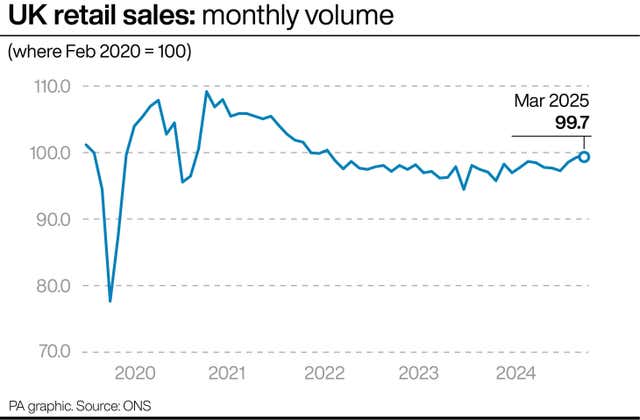Warm weather boosts clothing and DIY retailers in surprise March sales uplift
The Office for National Statistics said the overall quantity of sales increased by 0.4% in March.

UK retail sales unexpectedly rose last month as warmer weather boosted sales for fashion chains and garden centres, according to new official figures.
The overall quantity of sales increased by 0.4% in March, following a rise of 0.7% in February, the Office for National Statistics (ONS) said.
The figure beat forecasts after most analysts had been expecting sales to decline by 0.4% last month.
It marks a brighter start to the year for retailers with sales leaping by 1.4% in January, and March representing the third month in a row of growth.
Between January and March, the volume of sales rose by 1.6% compared with the previous quarter.
This was the biggest increase in nearly four years, since the spring of 2021, the ONS said.

Hannah Finselbach, ONS senior statistician, said: “The good weather helped to boost sales across a variety of sectors.
“Garden centres reported robust trading and the sunny weather also helped brighten sales of DIY goods and clothing.
“Food sales, particularly within supermarkets, again had a poor month.
“The bigger picture shows retail sales are up across the quarterly and annual period, but are still a little below pre-pandemic levels.”
Clothing stores enjoyed the strongest growth of all non-food retailers, with sales jumping by 3.7% compared with the previous month.
Second-hand retailers like antiques and auction houses benefited from a higher volume of sales in March, as well as stores selling garden supplies.
Many of the retailers pointed to good weather bringing in more shoppers, the ONS said, as temperatures rose in March and sunny spells continuing into April.
On the other hand, it was a weaker month for food retailers with sales dropping by 1.3% in March, following a 2.2% fall in February, driven by supermarkets.
A price war among UK supermarkets has heated up in recent months as some of the country’s biggest chains compete to attract squeezed shoppers.
Asda recently promised the company’s biggest price cuts in 25 years, putting pressure on the likes of Sainsbury’s and Tesco to slash their own prices, while discounters Aldi and Lidl continue to rapidly grow their share of the market.
April also saw an influx of bills rising for many households including electricity, water, and council tax.

Nicholas Found, head of commercial content for economics research consultancy Retail Economics, warned that beneath the “green shoots” non-essential spending remained stretched.
“March offered glimmers of hope for retailers, with warmer weather and longer evenings encouraging households to spend on gardening and DIY, while Mother’s Day provided a timely boost for beauty and gifting categories,” he said.
“But beneath these green shoots, discretionary spending remains under significant strain.
“With consumers bracing for a fresh wave of rising household bills, geopolitical tensions weighing on confidence and budget-related costs kicking in, retailers face an uphill battle to protect margins, sustain investment and navigate an increasingly complex trading environment.
“The outlook is clouded further by uncertainty around US trade tariffs, which has the potential to disrupt shipments if orders are cancelled and routes impacted.
“For shoppers, the focus remains firmly on value and carefully timed promotions, leaving big ticket spending stuck in second gear.”





